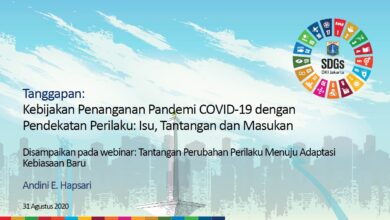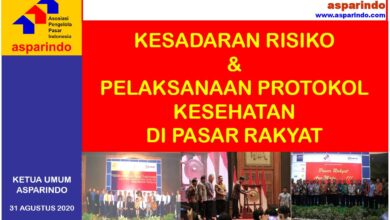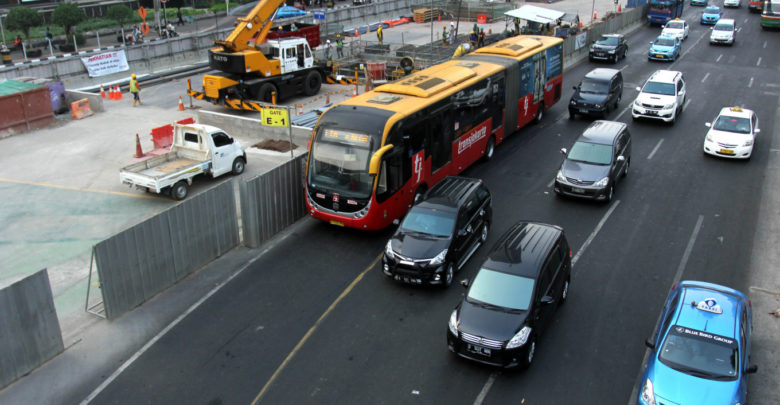
Fifteen years ago, many Jakartans thought a busway was a bad idea. Jakartans love their cars and relenting one lane exclusively for public buses was a novel, unthinkable idea.
Now, it enjoys increasing popularity and despite the imminent arrival of the country’s first MRT in March, Transjakarta still has a bright future as the first revolutionary public transit mode in the capital.
Fear of total congestion
In 2003, then-Jakarta governor Sutiyoso, a year before the launch of the busway, insisted that the city needed better public transportation. Otherwise, the city would have total congestion in 2014, when Jakartans would open their garage and drive out only to find bad congestion immediately in front of their house, said the governor, citing a 2000 report from the Japan International Cooperation Agency.
Inspired by TransMilenio in Bogota, Colombia, the Transjakarta system aims at making Jakartans leave their private cars at home and use the buses, which are fully air conditioned and subject to more regulations than other public buses, the drivers of which work under a setoran (revenue quota) system, where passengers can board and get off anywhere they like.
The first “corridor” opened on Jan. 15, 2004, serving Blok M in South Jakarta to Kota in West Jakarta, passing the business district Jl. Thamrin and Jl. Sudirman. Transjakarta became the first busway in Indonesia, even the first in Southeast and South Asia.
Charging a fare of Rp 3,500 (24 US cents), the buses initially attracted only those who usually rode the older public buses. But slowly, the busway began to gain popularity among middle-income white collar workers as well.
Now, it has transformed into a company managing hundreds of buses plying 13 corridors and several feeder routes. Fifteen years into service, the buses have become the backbone of the city’s transportation.
President director Agung Wicaksono told The Jakarta Post in a recent interview that the company is now boasting healthy growth. “In 2015, we had 300 buses. But by the end of 2018, we had 900 buses. The number of passengers in the past three years has also grown 23 percent,” he said.
The number includes smaller buses “feeding” passengers to the main corridors. Boasting the tagline #KiniLebihBaik (NowBetter), the company serves 155 feeder routes and served 189.77 million passengers last year. It aims at serving 231 million passengers by the end of this year by opening 80 new routes.
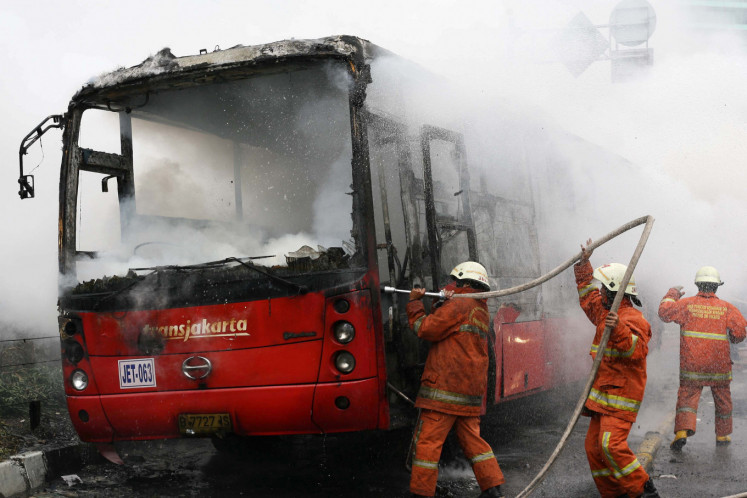
An older model Transjakarta bus parks among newer ones at the depot in Cawang, East Jakarta, on Jan. 2. For better or worse, the busway has changed the way Jakartans see buses.
Just like any new system, however, Transjakarta is not without faults. The buses have caught fire while carrying passengers. Some corridors also have long headway, making passengers wait for a long time for a bus to arrive. Many of the shelters and footbridges are in dire need of a revamp and better facilities for pedestrians.
Changing the way we see buses
But for better or worse, the busway has changed the way Jakartans see buses. First, it changed the way people saw roads, which were reserved for private vehicles, especially cars. With exclusive busway lanes, the system introduced the perspective that roads should be reserved for public transit.
Such an idea, however, was rejected, including by residents of upscale neighborhood Pondok Indah, who in 2007 refused to give up “their” roads for the busway for Corridor VIII.
Second, it changed the way the crew of public buses served passengers.
Before Transjakarta, Jakartans relied on big buses operated by companies like state-owned Damri and Mayasari Bhakti as well as smaller buses operated by Metro Mini and Kopaja. The bus drivers work under a system called setoran, in which they have to meet a certain revenue quota everyday and can take home the rest. With this system, many drivers wait for passengers anywhere they like, especially at busy spots like schools and markets.
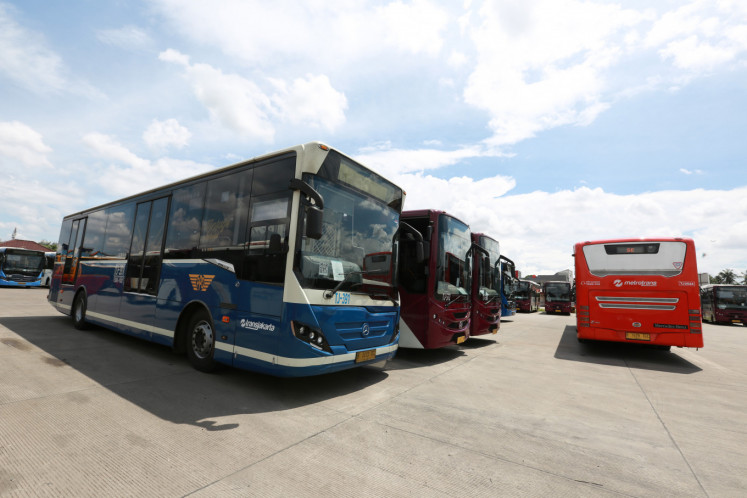 An older model Transjakarta bus parks among newer ones at the depot in Cawang, East Jakarta, on Jan. 2. For better or worse, the busway has changed the way Jakartans see buses. (JP/Wienda Parwitasari)
An older model Transjakarta bus parks among newer ones at the depot in Cawang, East Jakarta, on Jan. 2. For better or worse, the busway has changed the way Jakartans see buses. (JP/Wienda Parwitasari)
Transjakarta scrapped the system and offered an attractive monthly salary for drivers instead. It also offered a career path. That way, public buses were no longer identical to unsupervised, careless drivers speeding against each other.
This policy also faced rejection. Only days into the service in 2004, several drivers protested the new system. But, after some years, many thought the system was better not only for the passengers but also for their welfare too.
One long-time driver of Transjakarta is 46-year-old Mahmudi. He has been driving Transjakarta buses for 13 years, since the service began operating on Corridor 1. He began his career as a driver at the age of 18, driving a Transjakarta bus in 2005. He became a permanent employee in 2015.
Now, Mahmudi is a master driver. There are only 10 master drivers among the around 1,000 regular drivers. Mahmudi said master drivers bear bigger responsibilities compared to regular ones.
“I never thought there was a career path for a driver like me,” he said.
Besides driving a bus, master drivers are also tasked with acting as seniors who provide training and counseling to younger drivers. They are involved in various decision making processes, considering that drivers are the frontliners of the service.
“Not only have I put my four kids in school, I could save more for their future. I get all the social protections I need as a worker. I can see myself working here until I retire,” he said.
On the other side of the service, there are also loyal customers who have been counting on Transjakarta for years. Among them is Eka Mutri, who has been taking Transjakarta buses to commute from her house in Tanjung Priok, North Jakarta, to anywhere in the city in the past nine years.
“I used to take the Transjakarta bus to go to my campus in Kuningan [South Jakarta], and now I ride it to reach my office on Jl. Sudirman [Central Jakarta],” said the Tanjung Priok resident.
“Today I only have to wait for a few minutes for the next bus to arrive. The various routes enable me to go anywhere for only Rp 3,500. No traffic, no buskers and vendors – what’s not to love,” she added.
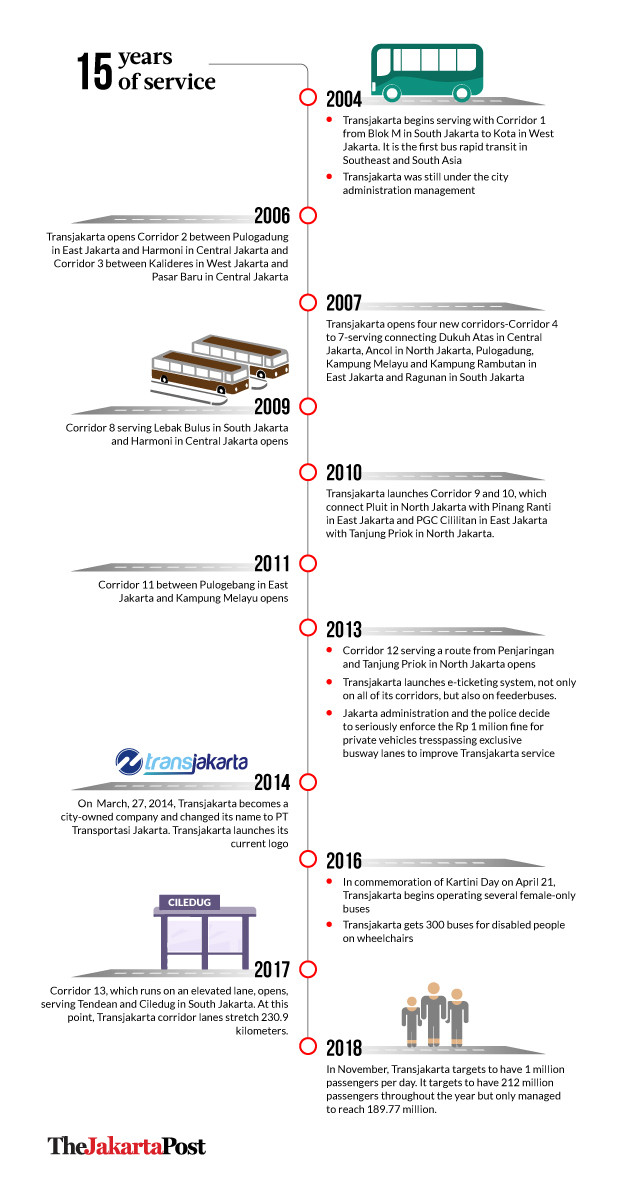
Timeline (JP/Kevin Setiawan)
Another customer, Cornelia Halim, has been using Transjakarta since 2010. She was happy with the improvements and because she was a frequent user of Corridor 1, she said she would be among the first to enjoy new improvements.
“When there’s an upgrade, like a new bus or service, Corridor 1 is often prioritized,” the 26-year-old said.
However, she said many facilities like shelters and footbridges were in need of a revamp.
Welcoming the MRT
Big cities around the world are proud of their MRT systems. New York City has the subway, London has the tube and Tokyo has the most extensive, sophisticated subway train system.
In March, Transjakarta will welcome the country’s first MRT, which was established by PT MRT Jakarta. Its first phase will serve commuters from Lebak Bulus in South Jakarta to the Hotel Indonesia traffic circle in Central Jakarta.
In December, the Greater Jakarta Transportation Agency (BPTJ) said in its transportation outlook that this year will be the beginning of a new era, when the MRT will be the backbone of the city’s transportation system. Other systems, including Transjakarta buses and commuter trains would take a supporting role, the BPTJ said.
Another player will also come to town.
The light rapid transit (LRT) will begin operations soon, serving passengers from Kelapa Gading in North Jakarta to Rawamangun in East Jakarta. The LRT is being constructed by city-owned developer PT Jakarta Propertindo.
“Right now, the busway is the city’s backbone. We must have the confidence to say that the other modes of transportation will be successful because we’ve been here long before them,” Agung said with pride.
Agung, a former director of operations and maintenance at MRT Jakarta, said Transjakarta welcomed the MRT and maintained a good relationship with MRT Jakarta so that they could work together to integrate their services. Their discussions are currently focusing on integrating routes and payments.
“It needs a comprehensive study to answer some questions, such as what are the best routes so that people can reach the MRT station in Lebak Bulus? Or what routes could Transjakarta provide on Corridor 1 to optimize the use of the MRT along Jl. Sudirman and Jl. MH Thamrin?” he said.
Yoga Adi Winarto, transportation expert from the Institute for Transportation and Development Policy, which is a consultant for Transjakarta, said although some people expected the MRT to serve as the backbone, the busway would always win.
“The busway could expand routes on existing roads, while it takes years to wait for the underground train to be developed. And although their routes overlap [on Jl. Sudirman, Central Jakarta], both services can support each other,” he said.
Customer Cornelia is perhaps an example of what Yoga foresaw about the MRT. Even though she said she welcomed the MRT, Cornelia would still use Transjakarta.
“Maybe I’ll stick with Transjakarta. The MRT trip ends in Central Jakarta which is still far away from my house,” said the West Jakarta resident.
Artikel ini dipublikasikan di https://www.thejakartapost.com/news/2019/01/15/revolutionary-transjakarta-proves-its-relevance-after-15-years.html
Oleh: Vela Andapita, The Jakarta Post
